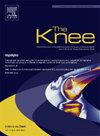年龄和体重指数与前交叉韧带重建后全膝关节置换术相关:一项回顾性研究
IF 2
4区 医学
Q3 ORTHOPEDICS
引用次数: 0
摘要
目的探讨年龄、体重指数(BMI)、免疫系统和炎症系统指标与前交叉韧带重建术(ACLR)后全膝关节置换术(TKA)成功率的关系。方法本回顾性病例对照研究包括三组接受ACLR的患者:(1)确诊为膝关节骨关节炎(OA)并进行TKA手术的患者(病例,n = 15),(2)未确诊为膝关节骨关节炎或TKA手术的患者(对照-1 [CON1], n = 15),以及(3)确诊为膝关节骨关节炎但在ACLR后未进行TKA手术的患者(对照-2 [CON2], n = 15)。对照组根据ACLR的性别和日期与病例(1:1:1)匹配。Logistic回归分析包括两个模型。模型1检查了ACLR后TKA的危险因素(病例vs CON1和CON2),模型2检查了记录在案的膝关节OA诊断的危险因素(病例和CON2 vs CON1)。危险因素包括ACLR时的年龄、BMI、免疫系统和炎症的全身性指标(全身性炎症反应指数、全身性免疫-炎症指数[SII]、中性粒细胞与淋巴细胞、血小板与淋巴细胞[PLR]、单核细胞与淋巴细胞比率)。结果年龄(p = 0.01)、BMI (p <;0.01)与TKA的高发生率相关。BMI升高(p = 0.02)、PLR升高(p = 0.05)和SII降低(p = 0.03)是膝关节OA诊断的危险因素。结论:ACLR术后BMI和全身炎症免疫指数升高与后续膝关节OA诊断的几率增加相关。增加的年龄和BMI与ACLR后膝关节OA诊断和TKA的几率增加相关。证据水平:III。有什么新发现?•体重指数和外周炎症免疫系统指数的增加与前交叉韧带重建后膝关节骨关节炎诊断的几率增加有关。•年龄和体重指数的增加与前交叉韧带重建后全膝关节置换术的几率增加有关。本文章由计算机程序翻译,如有差异,请以英文原文为准。
Age and body mass index associate with total knee arthroplasty after anterior cruciate ligament reconstruction: A retrospective study
Objective
To investigate the association of age, body mass index (BMI), and systemic indices of the immune system and inflammation with the odds of undergoing total knee arthroplasty (TKA) following anterior cruciate ligament reconstruction (ACLR).
Methods
This retrospective, case-control study consisted of three groups of patients that underwent ACLR: (1) those with a documented knee osteoarthritis (OA) diagnosis and TKA procedure (Cases, n = 15), (2) those without a documented knee OA diagnosis or TKA procedure (control-1 [CON1], n = 15), and (3) those with a documented knee OA diagnosis but without a TKA procedure after ACLR (control-2 [CON2], n = 15). Control groups were matched to the Cases (1:1:1) based on sex and date of ACLR. Logistic regression analyses consisted of two models. Model 1 examined risk factors of TKA (Cases vs CON1 and CON2) and Model 2 examined risk factors of a documented knee OA diagnosis (Cases and CON2 vs CON1) following ACLR. Risk factors included age at ACLR, BMI, and systemic indices of the immune system and inflammation (systemic inflammation response index, systemic immune-inflammatory index [SII], and neutrophil-to-lymphocyte, platelet-to-lymphocyte [PLR], and monocyte-to-lymphocyte ratios).
Results
Increased age (p = 0.01) and BMI (p < 0.01) were associated with significantly high odds of undergoing TKA. Increased BMI (p = 0.02) and PLR (p = 0.05) and decreased SII (p = 0.03) were risk factors for a documented knee OA diagnosis.
Conclusion
Increased BMI and systemic inflammatory-immune indices associated with increased odds of subsequent knee OA diagnosis following ACLR. Increased age and BMI associated with increased odds of subsequent knee OA diagnosis and TKA following ACLR.
Level of Evidence: III.
What are the new findings?
- •Increased body mass index and peripheral inflammatory-immune system indices are associated with increased odds of subsequent knee osteoarthritis diagnosis following anterior cruciate ligament reconstruction.
- •Increased age and body mass index are associated with increased odds of subsequent total knee arthroplasty following anterior cruciate ligament reconstruction.
求助全文
通过发布文献求助,成功后即可免费获取论文全文。
去求助
来源期刊

Knee
医学-外科
CiteScore
3.80
自引率
5.30%
发文量
171
审稿时长
6 months
期刊介绍:
The Knee is an international journal publishing studies on the clinical treatment and fundamental biomechanical characteristics of this joint. The aim of the journal is to provide a vehicle relevant to surgeons, biomedical engineers, imaging specialists, materials scientists, rehabilitation personnel and all those with an interest in the knee.
The topics covered include, but are not limited to:
• Anatomy, physiology, morphology and biochemistry;
• Biomechanical studies;
• Advances in the development of prosthetic, orthotic and augmentation devices;
• Imaging and diagnostic techniques;
• Pathology;
• Trauma;
• Surgery;
• Rehabilitation.
 求助内容:
求助内容: 应助结果提醒方式:
应助结果提醒方式:


